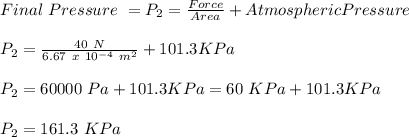
Physics, 15.12.2020 15:30 thicklooney
I have a cylinder shaped glass container that is 15 cm tall. It holds 100 cm^3 of nitrogen gas at 1 atm pressure (101.3 kPa) and 22 degrees C. I place a rubber stopper in the top so that no gas can escape. If a 40 N force is required to force the rubber stopper off the top of the flask, what temperature can I heat the nitrogen to with a Bunsen burner before the rubber stopper pops off

Answers: 1


Another question on Physics

Physics, 21.06.2019 19:40
Apackage of supplies is dropped from a plane, and one second later a second package is dropped. neglecting air resistance, the relative velocity of the 1st package viewed from the second will 56) a) increase. b) be constant. c) be zero. d) depend upon their weight. e) decrease
Answers: 1

Physics, 22.06.2019 18:30
Which word expression describes how much to calculate pressure
Answers: 1

Physics, 22.06.2019 20:40
Ablock of mass m = 2.5 kg is attached to a spring with spring constant k = 740 n/m. it is initially at rest on an inclined plane that is at an angle of theta= 26 with respect to the horizontal, and the coefficient of kinetic friction between the block and the plane is uk = 0.17. in the initial position, where the spring is compressed by a distance of d = 0.16 m, the mass is at its lowest position and the spring is compressed the maximum amount. take the initial gravitational energy of the block as zero. the block's initial mechanical energy is 9.472 j.b. if the spring pushes the block up the incline, what distance l in meters will the block travel before coming to rest? the spring remains attached to both the block and the fixed wall throughout its motion.
Answers: 3

Physics, 22.06.2019 22:20
One hazard of space travel is debris left by previous missions. there are several thousand masses large enough to detect by radar orbiting the earth, but there are far greater numbers of very small masses such as flakes of paint. calculate the force exerted by a 0.110 mg chip of paint that strikes a space shuttle window at a relative speed of 5.00 ✕ 103 m/s and sticks, given the collision lasts 6.00 ✕ 10-8 s. such a collision chipped the window of the ill-fated challenger in june 1983, causing $50,000 of damage.
Answers: 2
You know the right answer?
I have a cylinder shaped glass container that is 15 cm tall. It holds 100 cm^3 of nitrogen gas at 1...
Questions

English, 26.11.2021 19:50

SAT, 26.11.2021 19:50



Social Studies, 26.11.2021 19:50

Mathematics, 26.11.2021 19:50

Health, 26.11.2021 19:50


Health, 26.11.2021 19:50


Mathematics, 26.11.2021 19:50


SAT, 26.11.2021 19:50




Mathematics, 26.11.2021 19:50



Social Studies, 26.11.2021 19:50








